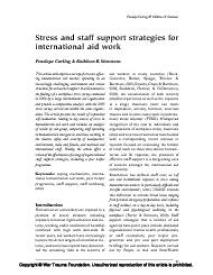Stress and staff support strategies for international aid work
This article will explore a variety of stressors affecting humanitarian aid workers operating in an increasingly challenging environment and review structures for aid worker support. It will summarise the findings of a workplace stress survey conducted in 2009 by a large international aid organisation and provide a comparative analysis with the 2003 stress survey carried out within the same organisation. The article presents the results of respondent self evaluations relating to key sources of stress in humanitarian aid work and includes an analysis of results by sub-group, comparing staff operating in humanitarian emergencies and those working in the relative safety and security of headquarters environments, male and female, and national and international staff. Finally, the article offers a review of the effectiveness of a range of organisational staff support strategies, including a peer helper programme.
Geachte bezoeker,
De informatie die u nu opvraagt, kan door psychotraumanet niet aan u worden getoond. Dit kan verschillende redenen hebben,
waarvan (bescherming van het) auteursrecht de meeste voorkomende is. Wanneer het mogelijk is om u door te verwijzen naar de bron
van deze informatie, dan ziet u hier onder een link naar die plek.
Als er geen link staat, kunt u contact opnemen met de bibliotheek,
die u verder op weg kan helpen.
Met vriendelijke groet,
Het psychotraumanet-team.
Reference:
Penelope Curling; Kathleen B. Simmons | 2010
In: Intervention: the international journal of mental health, psychosocial work and counselling in areas of armed conflict, ISSN 1571-8883 | 8 | 2 | 93-105
http://www.interventionjournal.com/sites/default/files/Stress_and_staff_support_strategies_for.2.pdf
In: Intervention: the international journal of mental health, psychosocial work and counselling in areas of armed conflict, ISSN 1571-8883 | 8 | 2 | 93-105
http://www.interventionjournal.com/sites/default/files/Stress_and_staff_support_strategies_for.2.pdf


